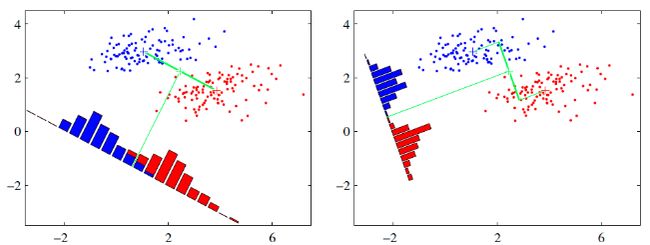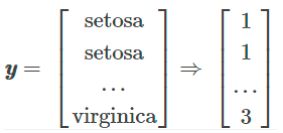降维算法之LDA及其实战
1.LDA介绍
LDA(全称:Linear Discriminant Analysis,中文名称:线性判别分析)是一种有监督学习的降维技术,也就是说它的数据集的每个样本是有类标签的。Ronald A. Fisher在1936年提出了线性判别方法。
用途:数据预处理中的降维,分类任务。
目标:LDA关心的是能够最大化类间区分度的坐标成分。将特征空间(数据集中的多维样本)投影到一个维度更小的k维子空间中,同时保持区分类别的信息。
原理:我们要将数据在低维度上进行投影,投影后希望每一种类别数据的投影点尽可能的接近,而不同类别的数据的类别中心之间的距离尽可能的大。(可以总结为LDA更关心分类,分类效果好了,类内的方差也就很小,类间的方差也就很大了。)

从直观上可以看出,右图要比左图的投影效果好,因为右图的红色数据和蓝色数据各个较为集中,且类别之间的距离明显。左图则在边界处数据混杂。
2.数学原理(仅以二分类为例)

目标:找到该投影 y = w T x y={{w}^{T}}x y=wTx
LDA分类的目标:使得不同类别之间的距离越远越好,同一类别之中的距离越近越好。
每类样例的均值: μ i = 1 N i ∑ x ∈ w i x {{\mu }_{i}}=\frac{1}{{{N}_{i}}}\sum\limits_{x\in {{w}_{i}}}{x} μi=Ni1x∈wi∑x
投影后的均值: μ i ~ = 1 N i ∑ y ∈ w i y = 1 N i ∑ x ∈ w i w T x = w T μ i \widetilde{{{\mu }_{i}}}=\frac{1}{{{N}_{i}}}\sum\limits_{y\in {{w}_{i}}}{y}=\frac{1}{{{N}_{i}}}\sum\limits_{x\in {{w}_{i}}}{{{w}^{T}}x}={{w}^{T}}{{\mu }_{i}} μi =Ni1y∈wi∑y=Ni1x∈wi∑wTx=wTμi
投影后的两类样本中心点尽量分离: J ( w ) = ∣ μ 1 ~ − μ 2 ~ ∣ = ∣ w T ( μ 1 − μ 2 ) ∣ J\left( w \right)=\left| \widetilde{{{\mu }_{1}}}-\widetilde{{{\mu }_{2}}} \right|=\left| {{w}^{T}}\left( {{\mu }_{1}}-{{\mu }_{2}} \right) \right| J(w)=∣μ1 −μ2 ∣=∣∣wT(μ1−μ2)∣∣

当然,只最大化 J ( w ) J\left( w \right) J(w)是不能满足的,X1的方向可以最大化 J ( w ) J\left( w \right) J(w),但是区分度不好,即类之间的距离不够大,而且类之间还有重叠。所以,光衡量类间是不够的,还需要衡量类内的,那么散列值指标就出来了,它表示样本点的密集程度,值越大,越分散,反之,越集中。
同类之间应该越密集些: s i ~ 2 = ∑ y ∈ w i ( y − μ i ~ ) 2 {{\widetilde{{{s}_{i}}}}^{2}}={{\sum\limits_{y\in {{w}_{i}}}{\left( y-\widetilde{{{\mu }_{i}}} \right)}}^{2}} si 2=y∈wi∑(y−μi )2
所以最后的目标函数变为: J ( w ) = ∣ μ 1 ~ − μ 2 ~ ∣ s 1 ~ 2 + s 2 ~ 2 J\left( w \right)=\frac{\left| \widetilde{{{\mu }_{1}}}-\widetilde{{{\mu }_{2}}} \right|}{{{\widetilde{{{s}_{1}}}}^{2}}+{{\widetilde{{{s}_{2}}}}^{2}}} J(w)=s1 2+s2 2∣μ1 −μ2 ∣
散列值公式展开: s i ~ 2 = ∑ y ∈ w i ( y − μ i ~ ) 2 = ∑ x ∈ w i ( w T x − w T μ i ) 2 = ∑ x ∈ w i w T ( x − μ i ) ( x − μ i ) T w {{\widetilde{{{s}_{i}}}}^{2}}={{\sum\limits_{y\in {{w}_{i}}}{\left( y-\widetilde{{{\mu }_{i}}} \right)}}^{2}}={{\sum\limits_{x\in {{w}_{i}}}{\left( {{w}^{T}}x-{{w}^{T}}{{\mu }_{i}} \right)}}^{2}}=\sum\limits_{x\in {{w}_{i}}}{{{w}^{T}}\left( x-{{\mu }_{i}} \right)}{{\left( x-{{\mu }_{i}} \right)}^{T}}w si 2=y∈wi∑(y−μi )2=x∈wi∑(wTx−wTμi)2=x∈wi∑wT(x−μi)(x−μi)Tw
散列矩阵(scatter matrices): s i 2 = ∑ x ∈ w i ( x − μ i ) ( x − μ i ) T {{s}_{i}}^{2}=\sum\limits_{x\in {{w}_{i}}}{\left( x-{{\mu }_{i}} \right)}{{\left( x-{{\mu }_{i}} \right)}^{T}} si2=x∈wi∑(x−μi)(x−μi)T
类内散布矩阵: s w = s 1 + s 2 {{s}_{w}}={{s}_{1}}+{{s}_{2}} sw=s1+s2
则 s i ~ 2 = w T s i w {{\widetilde{{{s}_{i}}}}^{2}}={{w}^{T}}{{s}_{i}}w si 2=wTsiw s 1 ~ 2 + s 2 ~ 2 = w T s w w {{\widetilde{{{s}_{1}}}}^{2}}+{{\widetilde{{{s}_{2}}}}^{2}}={{w}^{T}}{{s}_{w}}w s1 2+s2 2=wTsww
分子展开:

其中 s B {{s}_{B}} sB称为类间散布矩阵。
最终目标函数: J ( w ) = w T s B w w T s w w J\left( w \right)=\frac{{{w}^{T}}{{s}_{B}}w}{{{w}^{T}}{{s}_{w}}w} J(w)=wTswwwTsBw
分母归一化:如果分子、分母都是可以取任意值的,那就会产生无穷解,我们将分母的大小限制小于等于1。
最终目标函数实际上越大越好,也就是,我们希望取得这个函数的极大值,极大值的求取,我们是不是想到了拉格朗日这个神器。下面就用此方法进行求解。
拉格朗日乘子法:
c ( w ) = w T s B w − λ ( w T s w w − 1 ) c\left( w \right)={{w}^{T}}{{s}_{B}}w-\lambda \left( {{w}^{T}}{{s}_{w}}w-1 \right) c(w)=wTsBw−λ(wTsww−1)
⇒ d c d w = 2 s B w − 2 λ s w w = 0 \Rightarrow \frac{dc}{dw}=2{{s}_{B}}w-2\lambda {{s}_{w}}w=0 ⇒dwdc=2sBw−2λsww=0
⇒ s B w = λ s w w \Rightarrow {{s}_{B}}w=\lambda {{s}_{w}}w ⇒sBw=λsww
两边都乘以 s w {{s}_{w}} sw的逆: s w − 1 s B w = λ w {{s}_{w}}^{-1}{{s}_{B}}w=\lambda w sw−1sBw=λw(w就是矩阵 s w − 1 s B {{s}_{w}}^{-1}{{s}_{B}} sw−1sB的特征向量)
3.LDA实战(多分类为例,并将相关多分类所用到的公式附上)
3.1获取鸢尾花数据集
feature_dict = {i:label for i,label in zip(
range(4),
('sepal length in cm',
'sepal width in cm',
'petal length in cm',
'petal width in cm', ))}
import pandas as pd
df = pd.io.parsers.read_csv(
filepath_or_buffer = 'https://archive.ics.uci.edu/ml/machine-learning-databases/iris/iris.data',
header = None,
sep = ','
)
df.columns = [ l for i,l in sorted(feature_dict.items())] + ['class label']
# how='all’滤除全为NaN的行
df.dropna(how='all',inplace=True)
df.tail()
from sklearn.preprocessing import LabelEncoder
X = df[['sepal length in cm','sepal width in cm','petal length in cm','petal width in cm']].values
y = df['class label'].values
enc = LabelEncoder()
label_encoder = enc.fit(y)
y = label_encoder.transform(y) + 1
label_dict = {1: 'Setosa', 2: 'Versicolor', 3:'Virginica'}
标签值进行了转化,转化后的结果为:

3.3分别求三种鸢尾花数据在不同特征维度上的均值向量 mi
import numpy as np
# 小数点后四位
np.set_printoptions(precision=4)
mean_vectors = []
for cl in range(1,4):
mean_vectors.append(np.mean(X[y==cl],axis=0))
print('Mean Vector class %s: %s\n' %(cl, mean_vectors[cl-1]))
输出结果:
Mean Vector class 1: [5.006 3.418 1.464 0.244]
Mean Vector class 2: [5.936 2.77 4.26 1.326]
Mean Vector class 3: [6.588 2.974 5.552 2.026]
3.4计算两个 4×4 维矩阵:类内散布矩阵和类间散布矩阵
(1)类内散布矩阵
s w = ∑ i = 1 c s i {{s}_{w}}=\sum\limits_{i=1}^{c}{{{s}_{i}}} sw=i=1∑csi
s i = ∑ x ∈ D i n ( x − m i ) ( x − m i ) T {{s}_{i}}=\sum\limits_{x\in {{D}_{i}}}^{n}{\left( x-{{m}_{i}} \right){{\left( x-{{m}_{i}} \right)}^{T}}} si=x∈Di∑n(x−mi)(x−mi)T
m i = 1 n i ∑ x ∈ D i n x k {{m}_{i}}=\frac{1}{{{n}_{i}}}\sum\limits_{x\in {{D}_{i}}}^{n}{{{x}_{k}}} mi=ni1x∈Di∑nxk
m i {{m}_{i}} mi表示每一个类别的均值。
S_W = np.zeros((4,4))
for cl,mv in zip(range(1,4),mean_vectors):
class_sc_mat = np.zeros((4,4))
for row in X[y==cl]:
row,mv = row.reshape(4,1),mv.reshape(4,1)
class_sc_mat += (row-mv).dot((row-mv).T)
S_W += class_sc_mat
print('within-class Scatter Matrix:\n', S_W)
输出结果:
within-class Scatter Matrix:
[[38.9562 13.683 24.614 5.6556]
[13.683 17.035 8.12 4.9132]
[24.614 8.12 27.22 6.2536]
[ 5.6556 4.9132 6.2536 6.1756]]
(2)类间散布矩阵
s B = ∑ i = 1 c N i ( m i − m ) ( m i − m ) T {{s}_{B}}=\sum\limits_{i=1}^{c}{{{N}_{i}}\left( {{m}_{i}}-m \right){{\left( {{m}_{i}}-m \right)}^{T}}} sB=i=1∑cNi(mi−m)(mi−m)T
m是全局均值,而mi和Ni是每类样本的均值和样本数。
overall_mean = np.mean(X,axis=0)
S_B = np.zeros((4,4))
for i,mv in enumerate(mean_vectors):
n = X[y == i+1,:].shape[0]
mv = mv.reshape(4,1)
overall_mean = overall_mean.reshape(4,1)
S_B += n * (mv - overall_mean).dot((mv - overall_mean).T)
print('between-class Scatter Matrix:\n', S_B)
输出结果:
between-class Scatter Matrix:
[[ 63.2121 -19.534 165.1647 71.3631]
[-19.534 10.9776 -56.0552 -22.4924]
[165.1647 -56.0552 436.6437 186.9081]
[ 71.3631 -22.4924 186.9081 80.6041]]
3.5求解矩阵的特征值(特征向量:表示映射方向;特征值的绝对值:特征向量的重要程度)
# linalg线性代数模块,eig求解特征值和特征向量,inv求解逆矩阵
eig_vals, eig_vecs = np.linalg.eig(np.linalg.inv(S_W).dot(S_B))
for i in range(len(eig_vals)):
eigvec_sc = eig_vecs[:,i].reshape(4,1)
print('\nEigenvector {}: \n{}'.format(i+1, eigvec_sc.real))
print('Eigenvalue {:}: {:.2e}'.format(i+1, eig_vals[i].real))
输出结果:
Eigenvector 1:
[[ 0.2049]
[ 0.3871]
[-0.5465]
[-0.7138]]
Eigenvalue 1: 3.23e+01
Eigenvector 2:
[[-0.009 ]
[-0.589 ]
[ 0.2543]
[-0.767 ]]
Eigenvalue 2: 2.78e-01
Eigenvector 3:
[[ 0.8767]
[-0.2456]
[-0.2107]
[-0.356 ]]
Eigenvalue 3: -7.61e-16
Eigenvector 4:
[[-0.7968]
[ 0.4107]
[ 0.4176]
[-0.1483]]
Eigenvalue 4: 3.67e-15
(1)按特征值大小进行排序
eig_pairs = [(np.abs(eig_vals[i]), eig_vecs[:,i]) for i in range(len(eig_vals))]
# Sort the (eigenvalue, eigenvector) tuples from high to low
eig_pairs = sorted(eig_pairs, key=lambda k: k[0], reverse=True)
print('Eigenvalues in decreasing order:\n')
for i in eig_pairs:
print(i[0])
输出结果:
Eigenvalues in decreasing order:
32.27195779972982
0.2775668638400559
3.668801765648684e-15
7.606986544516927e-16
(2)衡量特征值的重要程度
print('Variance explained:\n')
eigv_sum = sum(eig_vals)
for i,j in enumerate(eig_pairs):
print('eigenvalue {0:}: {1:.2%}'.format(i+1, (j[0]/eigv_sum).real))
输出结果:
Variance explained:
eigenvalue 1: 99.15%
eigenvalue 2: 0.85%
eigenvalue 3: 0.00%
eigenvalue 4: 0.00%
(3)根据重要程度,选择前两维特征
W = np.hstack((eig_pairs[0][1].reshape(4,1), eig_pairs[1][1].reshape(4,1)))
print('Matrix W:\n', W.real)
输出结果:
Matrix W:
[[ 0.2049 -0.009 ]
[ 0.3871 -0.589 ]
[-0.5465 0.2543]
[-0.7138 -0.767 ]]
3.6降维
X_lda = X.dot(W)
assert X_lda.shape == (150,2), "The matrix is not 150x2 dimensional."
画图函数
import matplotlib.pyplot as plt
def plot_step_lda():
ax = plt.subplot(111)
for label,marker,color in zip(
range(1,4),('^', 's', 'o'),('blue', 'red', 'green')):
plt.scatter(x=X_lda[:,0].real[y == label],
y=X_lda[:,1].real[y == label],
marker=marker,
color=color,
alpha=0.5,
label=label_dict[label]
)
plt.xlabel('LD1')
plt.ylabel('LD2')
leg = plt.legend(loc='upper right', fancybox=True)
leg.get_frame().set_alpha(0.5)
plt.title('LDA: Iris projection onto the first 2 linear discriminants')
# hide axis ticks
plt.tick_params(axis="both", which="both", bottom=False, top=False,
labelbottom=True, left=False, right=False, labelleft=True)
# remove axis spines
ax.spines["top"].set_visible(False)
ax.spines["right"].set_visible(False)
ax.spines["bottom"].set_visible(False)
ax.spines["left"].set_visible(False)
plt.grid()
plt.tight_layout
plt.show()
plot_step_lda()
from sklearn.discriminant_analysis import LinearDiscriminantAnalysis as LDA
# LDA
sklearn_lda = LDA(n_components=2)
X_lda_sklearn = sklearn_lda.fit_transform(X,y)
参考文档:
https://www.cnblogs.com/pinard/p/6244265.html
https://blog.csdn.net/woaixuexihhh/article/details/85202077



